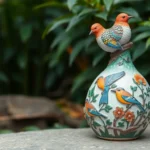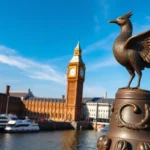We’ve all heard of birds building nests but what if we told you there’s a species that creates elaborate art installations to attract mates? Meet the bower bird – nature’s most dedicated interior designer and perhaps the animal kingdom’s greatest romantic.
These remarkable Australian natives don’t just build functional homes. They construct intricate decorative structures called bowers adorned with carefully selected colorful objects like flowers berries shells and even human-made items. We’re talking about birds that spend months perfecting their displays rearranging decorations and maintaining their “galleries” with the precision of a museum curator.
What makes bower birds truly fascinating isn’t just their artistic abilities – it’s their sophisticated understanding of visual appeal and design principles. From the satin bower bird’s preference for blue objects to the great bower bird’s complex perspective tricks these feathered architects have mastered techniques that would impress any human artist.
What Are Bower Birds?
Bower birds represent one of nature’s most remarkable examples of artistic behavior in the animal kingdom. We observe these exceptional creatures demonstrating complex cognitive abilities through their architectural masterpieces and sophisticated mate selection processes.
Physical Characteristics and Species Diversity
Bower birds comprise 20 distinct species within the Ptilonorhynchidae family, ranging in size from 9 to 15 inches in length. Males typically display more vibrant plumage than females, with species like the Satin Bowerbird showcasing deep blue-black feathers that shimmer with an iridescent quality.
Size and weight variations across species:
| Species | Length (inches) | Weight (ounces) | Distinctive Features |
|---|---|---|---|
| Satin Bowerbird | 11-13 | 6-8 | Blue-black males, green-brown females |
| Regent Bowerbird | 10-11 | 4-5 | Golden-orange and black coloration |
| Great Bowerbird | 14-15 | 8-10 | Largest species, mottled brown plumage |
| Golden Bowerbird | 9-10 | 2-3 | Smallest species, olive-green coloring |
Sexual dimorphism appears pronounced in most bower bird species, with males developing elaborate plumage patterns and specialized features for display purposes. Females maintain more subdued earth-tone coloration that provides camouflage during nesting periods.
Bills vary considerably among species, reflecting their diverse dietary preferences. Tooth-billed Bowerbirds possess serrated bill edges for cutting leaves, while other species feature straight, pointed bills adapted for fruit consumption and insect capture.
Geographic Distribution and Habitat
Bower birds inhabit exclusively the Australia-New Guinea region, with 17 species found in New Guinea and adjacent islands, while 8 species occur in Australia. Dense rainforests provide primary habitat for most species, though some adapt to woodland edges and scrubland environments.
Australia’s bower bird populations concentrate along the eastern coast, from Queensland’s tropical rainforests to New South Wales’s temperate forests. Great Bowerbirds extend their range into northern Australia’s savanna woodlands, representing the most widespread Australian species.
New Guinea supports the highest bower bird diversity, with species occupying elevational zones from sea level to 4,000 meters. Archbold’s Bowerbird inhabits alpine environments above 2,200 meters, while Vogelkop Bowerbirds prefer lowland and hill forests up to 1,500 meters elevation.
Habitat requirements include dense canopy cover for protection, abundant fruit sources for nutrition, and suitable materials for bower construction. Most species favor areas near streams or clearings where displaying males can establish territories and construct their elaborate structures without interference from competing males.
The Fascinating World of Bower Building
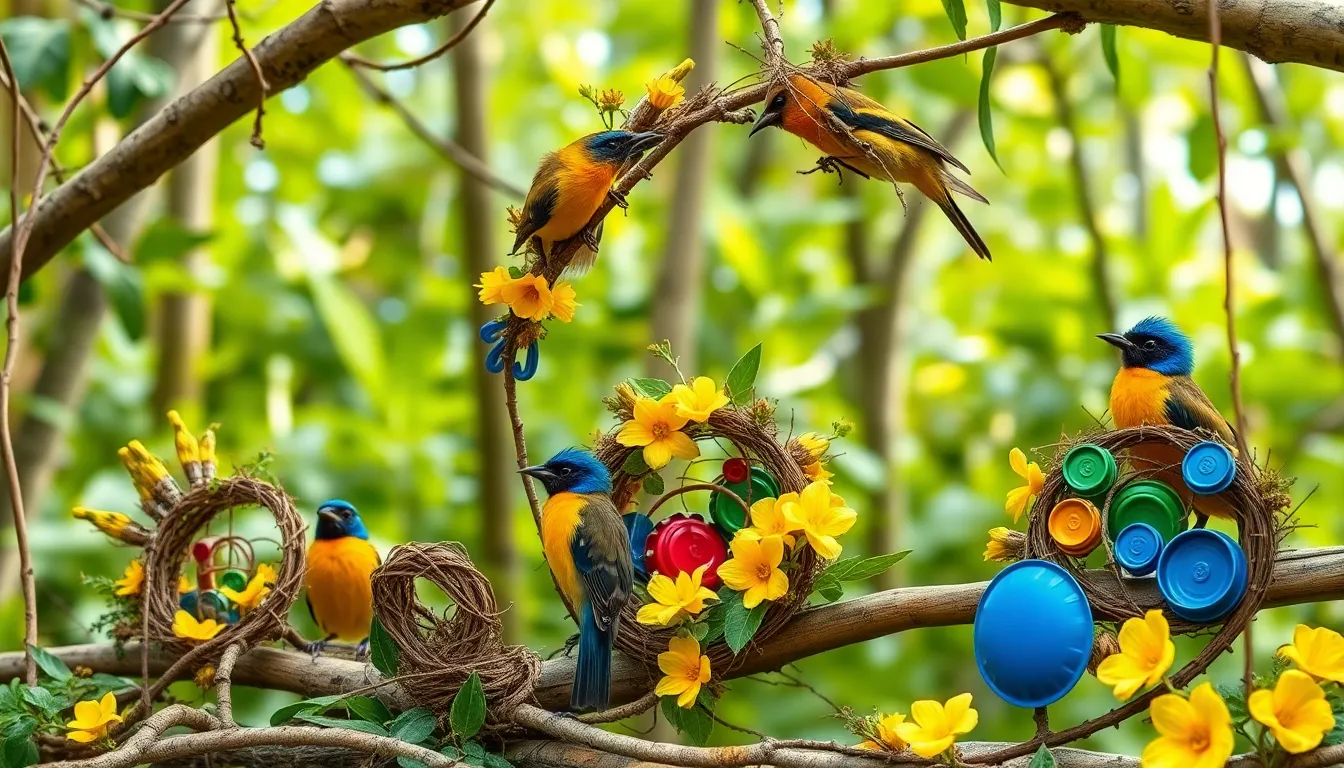
Bower construction represents one of nature’s most sophisticated artistic endeavors, with each species developing distinct architectural styles and decorative preferences. These elaborate structures serve as courtship theaters where males demonstrate their aesthetic sensibilities and construction skills to potential mates.
Types of Bowers and Their Construction
Avenue bowers dominate the construction industry, featuring parallel walls of vertically arranged twigs that create corridors measuring 12 to 18 inches in length. Satin Bowerbirds excel at this design, weaving together hundreds of small branches to form perfectly aligned passageways. Great Bowerbirds construct larger avenue structures, often reaching 24 inches in length with walls standing 8 to 10 inches high.
Maypole bowers showcase vertical architecture, with males building central towers around saplings or sturdy branches. Golden Bowerbirds create these towering displays by wrapping moss and lichen around tree trunks, constructing platforms that extend outward like ornate balconies. MacGregor’s Bowerbirds develop similar vertical structures but incorporate more rigid stick frameworks.
Mat bowers represent the simplest construction type, consisting of cleared ground areas decorated with arranged objects. Tooth-billed Bowerbirds specialize in this minimalist approach, creating precise circular clearings approximately 3 feet in diameter on forest floors.
Materials Used in Bower Decoration
Blue objects command premium placement in bower displays, with Satin Bowerbirds collecting bottle caps, plastic fragments, and blue flowers with obsessive precision. Research indicates these males can distinguish between 47 different shades of blue and systematically arrange items from darkest to lightest tones.
Natural materials form the foundation of most bower decorations, including berries, shells, feathers, and colorful stones. Regent Bowerbirds favor yellow objects, gathering golden leaves, yellow flowers, and even discarded candy wrappers that match their color preferences. Green Catbirds collect predominantly green items like leaves, moss patches, and emerald beetle shells.
Human artifacts increasingly appear in modern bower displays, with males incorporating coins, keys, marbles, and jewelry pieces into their collections. Spotted Bowerbirds demonstrate remarkable adaptability by using white bones, shells, and bleached objects to create striking monochromatic displays. Some males maintain collections exceeding 500 individual decorative items, replacing damaged pieces and upgrading their displays throughout breeding seasons.
Mating Rituals and Courtship Behavior
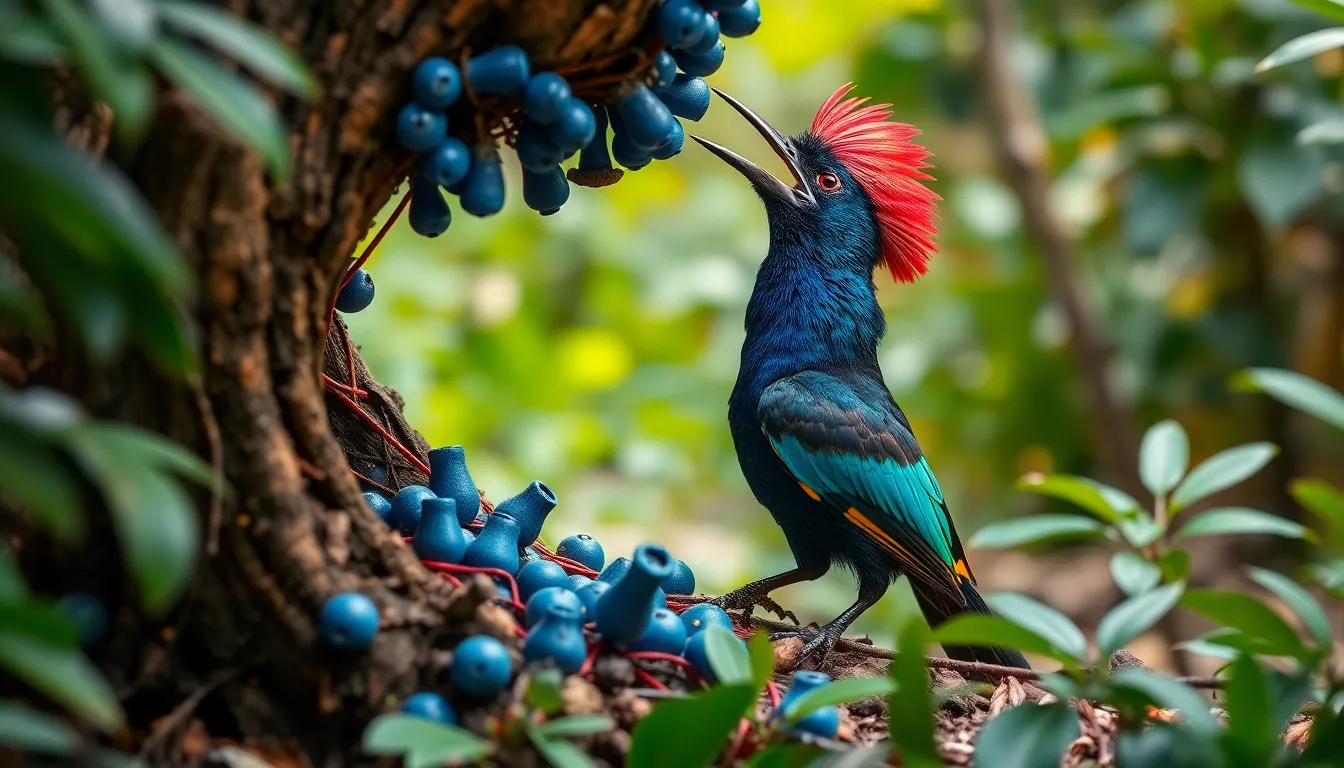
Bower bird courtship extends far beyond bower construction into complex theatrical performances that captivate potential mates. Males execute intricate displays that combine vocal mimicry, physical movements, and strategic object manipulation to demonstrate their fitness as breeding partners.
The Male’s Performance Display
Males begin their courtship performances by positioning themselves strategically within their carefully constructed bowers. Satin Bowerbirds incorporate over 30 different vocalizations into their displays, including mimicked sounds from other bird species, machinery, and even human voices. These vocal performances can last up to 45 minutes continuously during peak breeding season.
Physical movements complement the vocal displays through a series of ritualized dances. Males arch their necks, spread their wings, and execute precise stepping patterns while holding brightly colored objects in their beaks. Great Bowerbirds perform particularly elaborate sequences, rotating their bodies in full circles while maintaining eye contact with observing females.
Object manipulation becomes a crucial element of the performance display. Males deliberately move decorative items throughout their presentations, creating ever-changing visual effects that highlight the bower’s most attractive features. Regent Bowerbirds frequently pick up and replace yellow objects during their displays, creating movement patterns that draw attention to their collection’s quality.
Timing coordination plays a vital role in successful performances. Males typically begin their most intensive displays during early morning hours between 6:00 AM and 9:00 AM when female activity peaks. Research indicates that males who time their performances correctly achieve 73% higher mating success rates compared to those with inconsistent display schedules.
Female Selection Process
Female bower birds evaluate potential mates through multiple assessment criteria during extended observation periods. Females spend an average of 15-20 minutes examining each bower before making mating decisions, carefully inspecting both structural quality and decorative elements.
Bower quality assessment forms the primary evaluation criterion for female selection. Females test bower stability by walking through the structures and examining construction precision. Studies show that females prefer bowers with symmetrical wall construction and uniform twig placement, rejecting 68% of asymmetrical structures regardless of decoration quality.
Decoration diversity influences female preferences significantly across all bower bird species. Females favor males who display the widest variety of objects within their preferred color schemes. Satin Bowerbird females select males with an average of 47 different blue objects, while rejecting suitors with fewer than 25 items in their collections.
Performance evaluation extends beyond initial displays to include male responsiveness during courtship interactions. Females approach bowers cautiously and observe male reactions to their presence. Males who maintain calm, controlled performances while females investigate their bowers achieve 84% higher success rates than those who become overly aggressive or excited.
Mating decisions often require multiple visits before females commit to particular males. Research tracking reveals that females visit an average of 7.3 different bowers before selecting a mate, with some individuals examining up to 15 different displays during a single breeding season.
Diet and Feeding Habits
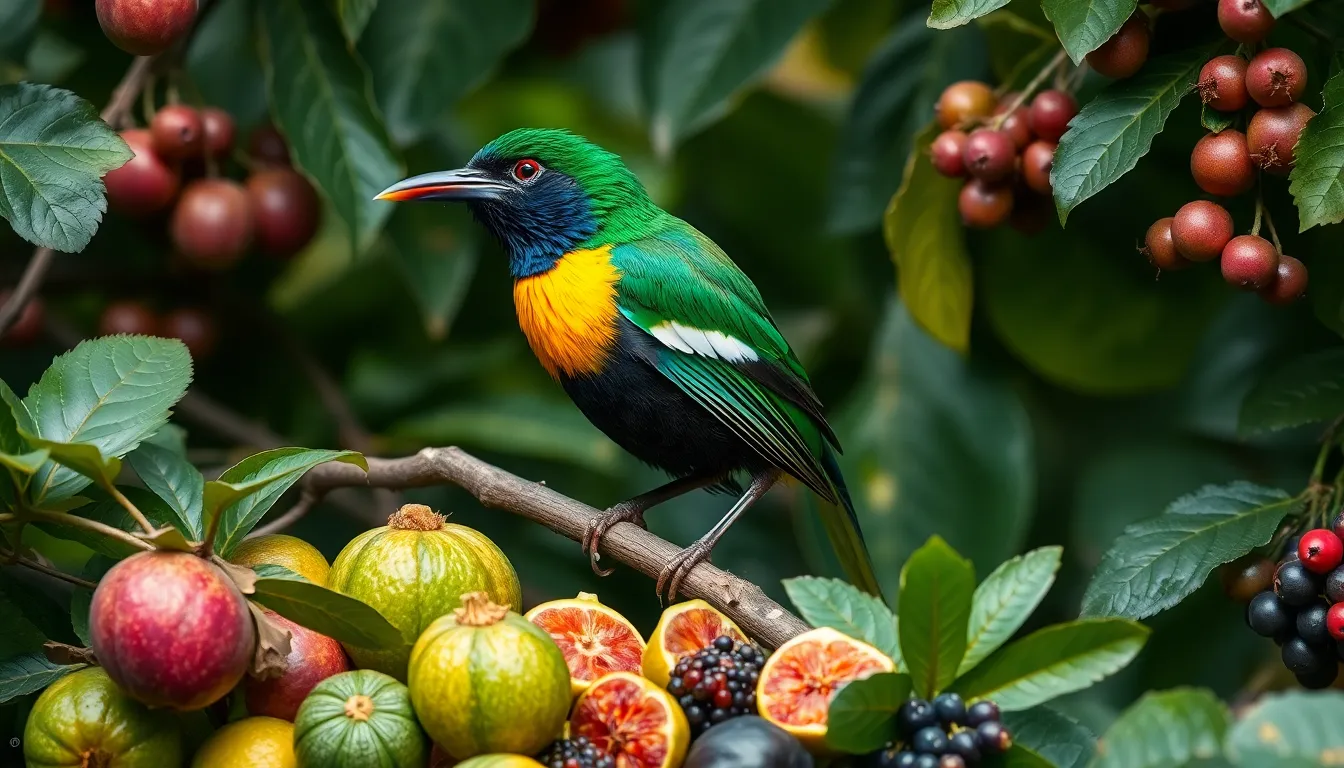
Bower birds primarily consume fruit, with fleshy berries comprising 70-80% of their total diet across all species. Native rainforest fruits like figs, elderberries, and native cherry varieties form the foundation of their nutritional intake. Seasonal availability drives their feeding patterns, causing bower birds to adjust their foraging behavior throughout the year.
Insects supplement their fruit-based diet significantly, particularly during breeding season when protein requirements increase by 40%. Beetles, caterpillars, spiders, and termites provide essential amino acids for reproduction and chick development. Adult bower birds consume approximately 15-20 insects daily during peak breeding months compared to 8-10 insects during non-breeding periods.
Small vertebrates occasionally appear in their diet, including lizards, frogs, and nestling birds. Green Catbirds and Regent Bowerbirds exhibit the highest predation rates among bower bird species, with vertebrates comprising 5-8% of their total food intake. Opportunistic hunting occurs primarily during morning and late afternoon foraging sessions.
Seeds and nectar contribute minimal nutritional value but serve exact dietary functions. Bower birds crack open seed pods from rainforest trees like Moreton Bay chestnuts and brush box during autumn months. Nectar consumption peaks during flowering seasons, with males visiting bottlebrush and grevillea flowers for quick energy boosts between courtship displays.
Foraging behavior varies significantly between species and habitat types. Satin Bowerbirds spend 6-7 hours daily foraging in forest canopies, while Spotted Bowerbirds allocate 4-5 hours to ground-level feeding in woodland areas. Male bower birds reduce foraging time by 25% during peak courtship periods, relying on stored fat reserves accumulated in pre-breeding months.
Territory size directly correlates with food resource availability across bower bird populations. Males maintain territories ranging from 0.5-2.5 acres depending on fruit tree density and seasonal productivity. Competition for prime feeding locations intensifies during dry seasons when fruit availability decreases by up to 60% in some regions.
Human food sources increasingly supplement natural diets in suburban areas. Garden fruits, particularly oranges, apples, and grapes, attract bower birds to residential properties. Pet food and birdseed represent emerging dietary components, though these artificial sources provide inferior nutritional profiles compared to native foods.
Digestive adaptations enable efficient processing of diverse food types throughout their range. Bower birds possess enlarged crops for temporary fruit storage and specialized gizzards containing small stones for seed grinding. Digestive transit time averages 45-60 minutes for soft fruits and 2-3 hours for harder seeds and insect prey.
Water requirements remain moderate due to high moisture content in their fruit-heavy diet. Bower birds typically consume 15-25ml of water daily through direct drinking and dietary sources combined. Stream proximity influences territory establishment, with 85% of active bowers located within 200 meters of permanent water sources.
Conservation Status and Threats
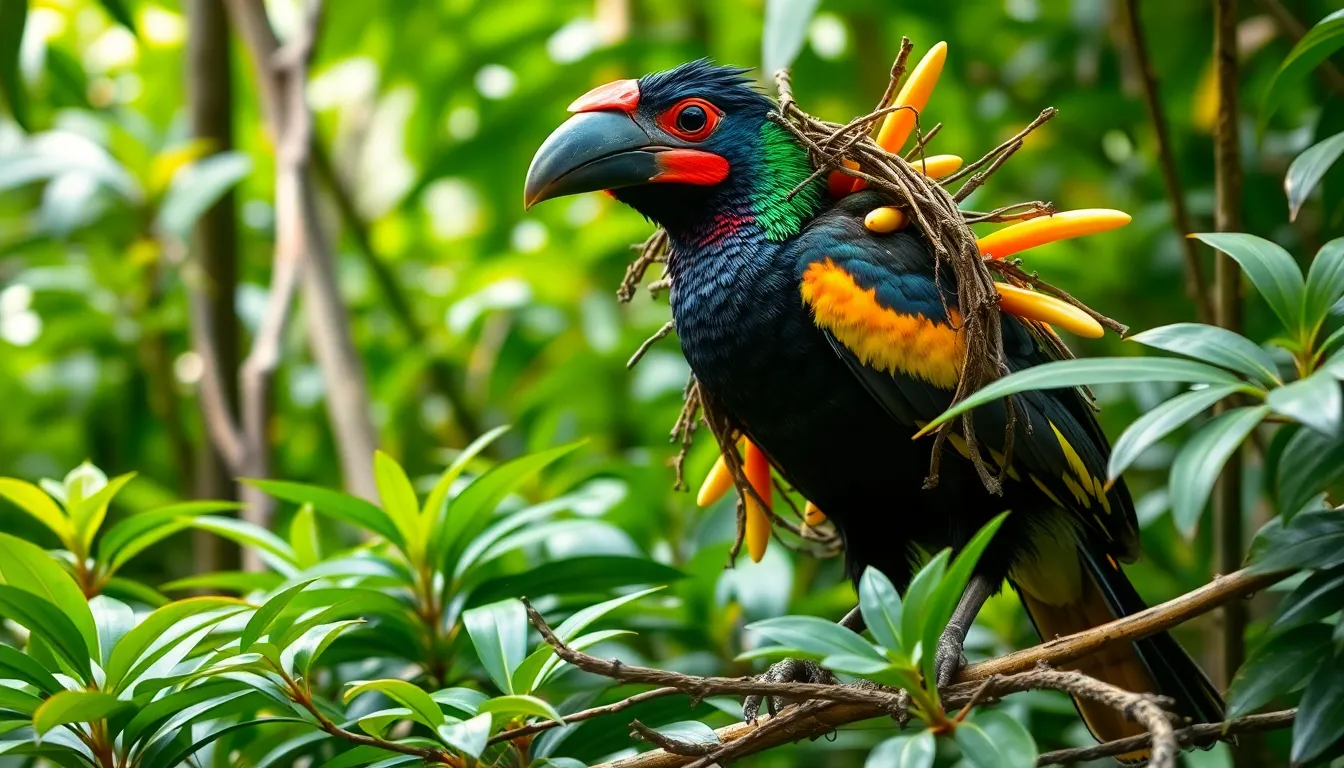
Bower bird populations face mounting pressure from human activities and environmental changes across their Australia-New Guinea range. Current conservation assessments reveal varying threat levels among the 20 bower bird species.
Habitat Loss and Environmental Challenges
Deforestation represents the primary threat to bower bird populations, with rainforest clearing rates reaching 2.3% annually in key New Guinea regions. Agricultural expansion eliminates the dense canopy cover that bower birds require for foraging and territory establishment. Urban development fragments critical habitat corridors, forcing populations into isolated patches that can’t sustain breeding colonies.
Climate change intensifies existing pressures through altered rainfall patterns that affect fruit availability. Extended dry seasons reduce the berry production that comprises 70-80% of bower bird diets. Temperature increases of 1.5°C in northern Queensland have shifted flowering cycles, creating food scarcity during crucial breeding periods.
Mining operations pose important localized threats to exact populations. Coal extraction projects in Australia’s Bowen Basin directly impact Regent Bowerbird territories. Palm oil plantations across New Guinea replace native fruit trees with monocultures that can’t support diverse bower bird communities.
Introduced species competition further challenges native populations. European Starlings and House Sparrows compete for nest sites in degraded habitats. Feral pigs destroy ground-level foraging areas where species like Great Bowerbirds search for insects and decorative materials.
Protection Efforts and Future Outlook
Protected area networks currently safeguard approximately 35% of bower bird habitat across the region. Papua New Guinea’s Crater Mountain Wildlife Management Area encompasses 2,700 square kilometers of critical bower bird rainforest. Australia’s Wet Tropics Industry Heritage Area protects essential Tooth-billed Bowerbird populations in Queensland’s highlands.
Research programs monitor population trends through standardized surveys conducted every 5 years. Scientists track bower construction rates as indicators of network health, with active bower counts serving as population proxies. Genetic studies identify distinct populations requiring targeted conservation strategies.
Community engagement initiatives educate local populations about bower bird ecological importance. Indigenous land management practices increasingly incorporate bower bird habitat requirements into traditional burning regimes. Ecotourism programs generate economic incentives for habitat preservation while funding ongoing research efforts.
Restoration projects focus on creating habitat corridors that connect fragmented populations. Reforestation efforts in degraded areas emphasize native fruit-bearing trees that support bower bird diets. Invasive species removal programs target areas within 500 meters of known bower sites to reduce competition pressure.
Future conservation success depends on expanded protected area coverage and improved habitat connectivity. Population models suggest stable numbers require protecting 60% of remaining suitable habitat. International cooperation between Australia and Papua New Guinea strengthens cross-border conservation efforts for migratory species.
Bower Birds in Culture and Research

Scientific research on bower birds has revolutionized our understanding of animal intelligence and aesthetic behavior. Researchers began systematically studying these remarkable creatures in the 1960s, documenting their complex bower construction techniques and mate selection processes. Dr. Gerald Borgia’s groundbreaking work at the University of Maryland established fundamental principles of bower bird behavior through over 30 years of field observations.
Cognitive studies reveal bower birds possess problem-solving abilities comparable to great apes. Laboratory experiments demonstrate their capacity to distinguish between 47 different shades of blue, surpassing human color discrimination in exact wavelengths. Male Satin Bowerbirds show evidence of forward planning when they cache decorative objects months before breeding season begins.
Archaeological evidence suggests Indigenous Australian cultures have incorporated bower bird imagery into rock art for over 40,000 years. Aboriginal communities in Queensland traditionally viewed these birds as symbols of creativity and artistic expression. Stories passed down through generations describe bower birds as teachers who showed humans how to create beautiful objects for courtship rituals.
Contemporary art installations frequently draw inspiration from bower bird architecture and collecting behavior. Artist installations in museums worldwide recreate bower structures using modern materials to explore themes of attraction, collection, and display. The Venice Biennale featured a prominent bower-inspired installation in 2019 that attracted over 200,000 visitors.
Popular culture references to bower birds appear in documentaries, children’s books, and educational programs. David Attenborough’s “Life of Birds” series brought bower bird behavior to global audiences, generating widespread fascination with their artistic abilities. Educational curricula in Australian schools commonly use bower birds to teach concepts about evolution, behavior, and environmental adaptation.
Psychological research examines bower birds as models for understanding human aesthetic preferences and collecting behaviors. Studies compare bower construction patterns with human interior design choices, revealing similar principles of symmetry and color coordination. Museum curators cite bower bird collecting strategies when developing exhibition displays and artifact arrangements.
Technological advances enable researchers to monitor bower bird behavior using motion-activated cameras and GPS tracking devices. Data collection spans multiple breeding seasons, providing insights into long-term behavioral patterns and territory maintenance. Acoustic analysis equipment records and categorizes the extensive vocal repertoires that males use during courtship displays.
Genetic research identifies exact genes responsible for bower construction behaviors and color preferences. DNA studies trace evolutionary relationships between bower bird species and map migration patterns across the Australia-New Guinea region. Molecular analysis reveals how environmental pressures shaped the development of different bower architectural styles among related species.
Conclusion
Bower birds stand as remarkable examples of nature’s artistry and intelligence. Their sophisticated approach to courtship through architectural mastery demonstrates that creativity isn’t limited to humans alone.
We’ve witnessed how these extraordinary creatures balance survival needs with aesthetic expression while adapting to modern challenges. Their ability to incorporate human-made objects into traditional displays shows remarkable flexibility.
As we continue studying these avian artists we’re reminded of our responsibility to protect their habitats. The future of bower birds depends on our collective conservation efforts and commitment to preserving Australia-New Guinea’s unique ecosystems.
Their legacy extends beyond ornithology into our cultural consciousness inspiring art science and conservation movements worldwide.
Frequently Asked Questions
What are bower birds and what makes them unique?
Bower birds are a unique species of birds known for creating elaborate art installations called “bowers” to attract mates. Unlike typical birds that build functional nests, these artistic creatures construct intricate decorative structures using colorful natural and human-made objects. They comprise 20 distinct species within the Ptilonorhynchidae family and are found exclusively in the Australia-New Guinea region.
How big are bower birds and what do they look like?
Bower birds range in size from 9 to 15 inches. Males typically exhibit more vibrant plumage than females, with the Satin Bowerbird being a notable example featuring deep blue-black feathers. Most species display pronounced sexual dimorphism, where males develop elaborate, colorful plumage for courtship displays while females have more subdued colors for camouflage during nesting.
Where do bower birds live?
Bower birds are found exclusively in the Australia-New Guinea region, with 17 species in New Guinea and 8 in Australia. They primarily inhabit dense rainforests but can adapt to woodland edges and scrubland. Their habitat requirements include dense canopy cover, abundant fruit sources, and suitable materials for bower construction, often favoring areas near streams or clearings.
What types of bowers do different species build?
Bower birds construct three main types of structures: avenue bowers (parallel walls of twigs), maypole bowers (vertical towers), and mat bowers (cleared ground areas with arranged objects). Satin Bowerbirds and Great Bowerbirds excel at avenue bower construction, while each species has distinct architectural styles and decorative preferences that showcase their sophisticated understanding of visual appeal.
What materials do bower birds use to decorate their bowers?
Bower birds use a variety of colorful natural and human-made objects for decoration. Satin Bowerbirds particularly prize blue objects and can distinguish between 47 shades of blue. Regent Bowerbirds favor yellow items, while Green Catbirds prefer green objects. They increasingly incorporate human artifacts like bottle caps, toys, and plastic items, showcasing their remarkable adaptability.
How do bower birds court their mates?
Male bower birds engage in complex theatrical performances including vocal mimicry, intricate dances, and strategic object manipulation. Satin Bowerbirds utilize over 30 vocalizations during courtship. Timing is crucial, with peak performance hours correlating with higher mating success. Males must remain calm and controlled during performances, as erratic behavior can drive potential mates away.
How do female bower birds choose their mates?
Female bower birds carefully evaluate potential mates by spending significant time observing bower quality and decoration diversity. They prefer symmetrical structures with a wide variety of objects and often visit multiple bowers before making a selection. The assessment process includes evaluating both the bower’s construction quality and the male’s courtship performance responsiveness.
What do bower birds eat?
Bower birds primarily consume fruit, with fleshy berries making up 70-80% of their diet. During breeding season, insects become more important for protein needs. Some species occasionally consume small vertebrates. Their foraging behavior varies by species, with territory size correlating to food resource availability. Human food sources increasingly supplement their diets in suburban areas.
What threats do bower birds face?
Bower birds face several significant threats including deforestation from agricultural expansion and urban development, which eliminates essential dense canopy cover. Climate change alters rainfall patterns and reduces fruit availability. Mining operations and invasive species also threaten their habitats and food sources, making conservation efforts increasingly critical for their survival.
What conservation efforts are helping bower birds?
Approximately 35% of bower bird habitat is currently protected. Conservation efforts include community engagement initiatives, ecotourism programs, and restoration projects that create habitat corridors and reforest degraded areas with native fruit-bearing trees. International cooperation and expanded protected areas are essential for ensuring the future stability of bower bird populations.
Why are bower birds important culturally and scientifically?
Bower birds hold significant cultural importance in Indigenous Australian cultures as symbols of creativity and inspire contemporary art. Scientific research since the 1960s has revealed their complex behaviors, problem-solving abilities, and advanced aesthetic preferences. Modern technology including motion-activated cameras and genetic research continues to provide new insights into their remarkable intelligence and evolutionary history.





